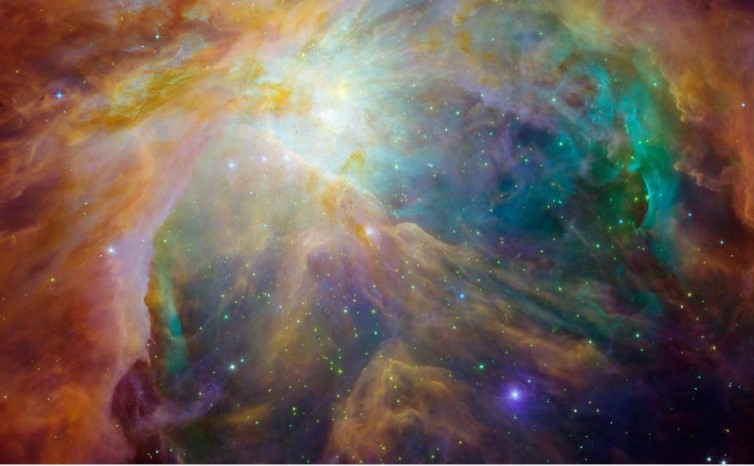The Orion nebula

The Orion Nebula is one of the most interesting objects in the deep sky. It is a regular target of amateur astronomers, an inevitable goal of astrophotographers and the subject of constant observation and study by professional astronomers of various specialties.
In Messier’s catalog it was introduced under serial number 42, and in NGC under number 1976. It is located under Orion’s belt of the constellation of the same name in the “sword” of the great hunter.
The belt is an asterism made up of three bright stars: Alnitak, Alnilam and Mintaka, and the sword is a nebulous object that represented the weapon of a mythical hero in the imagination of ancient observers.
The Orion Nebula is a little over 1350 light-years away from us, and now we see it as it was in the early Middle Ages, when the Arabs conquered North Africa. In ancient texts you will find that the Orion Nebula is called the Great Orion Nebula. If you know where to look for it, you can see it with the naked eye as a pale cloud.

For astronomers, the Orion Nebula is an inexhaustible source of knowledge. In it, they observe the formation of stars and the formation of planetary systems from collapsing clouds of gas and dust. They observe protoplanetary disks, brown dwarfs and turbulent flows of gases and ionizing radiation from nearby stars.
They also observe powerful giant clouds of hydrogen being pierced by supersonic bullets made of gas. Each such impact has a diameter 10 times larger than the orbit of Pluto. Each is charged with red-hot iron atoms that emit bright blue rays and they were formed a thousand years ago in some still unknown wild event.
In fact, it is estimated that there are at least 700 stars in the nebula in various stages of their development. The youngest are less than 300,000 years old, and the brightest among them are perhaps only ten thousand years old.
Recent observations by the Hubble Space Telescope have shown that the nebula contains over 150 protoplanetary disks in the earliest stages of the formation and development of solar systems.
These disks are made of material left over from the formation of the parent star. New planets are now forming in them. One day, maybe in just a billion years, someone will be watching us from there.
In the center of the nebula there is an open cluster of stars, named Trapezoid (Trapezium Cluster). It was discovered by Galileo Galilei on February 4, 1617. Perhaps it is just part of a much larger cluster of two thousand stars that spans around 20 light years.
The nebula has a pronounced greenish color with areas of red and purple blue. The red color comes from H alpha recombination, the violet-pale is a reflection of radiation from massive O-class stars located in the core of the nebula, and the greenish color has long been a puzzle for astronomers because no known spectral line matched it.

It was also observed in other nebulae and Sir William Huggins, an English astronomer and pioneer in astronomical spectroscopy, believed that it was an unknown element that was named after the nebula, so they called it “nebulium”.
However, six decades later, in 1927, the American astronomer Ira Bowen discovered that the greenish color comes from ionized oxygen and nitrogen under conditions unknown on Earth.
A few extra historical facts
It is possible that the Orion Nebula was also noticed by the Mayans in their myth “Three Hearthstones”.
If this is true then two of the stones would refer to the stars at the base of Orion, Rigel, and Saiph, while the third would be the star Alnitak at the top of the belt.

Those three stars form an almost perfect triangle, with Orion’s sword in the middle.
However, the great astronomers of ancient times, Ptolemy and Al Sufi, don’t mention this nebula, although they both listed nebular spots all over the sky.
It is particularly interesting that not even Galileo himself, who was the first to systematically search this area with a telescope and who was the first to spot the aforementioned Trapezoid, does not mention the Orion Nebula.
It is, however, possible that in his time it was not as conspicuous as it is today. Or, as some suggest, his telescope had a narrow field of view and it was impossible for him to notice it.
Did you know that here at OSR you can name stars? You can even pick one within the Orion constellation and view it in 3D!

